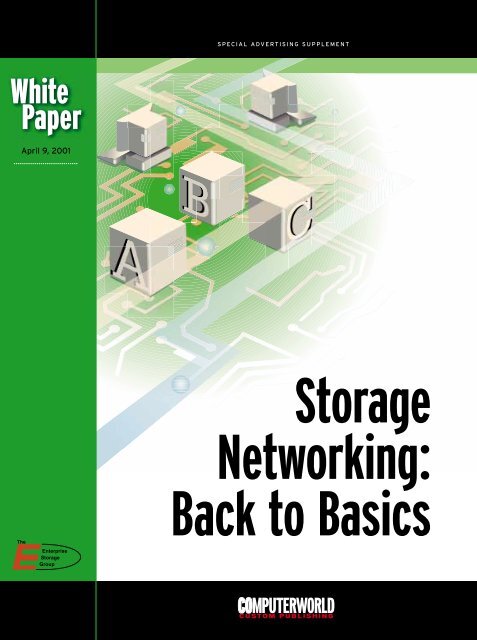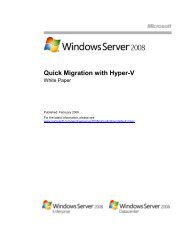Storage Networking - Computerworld
Storage Networking - Computerworld
Storage Networking - Computerworld
You also want an ePaper? Increase the reach of your titles
YUMPU automatically turns print PDFs into web optimized ePapers that Google loves.
SPECIAL ADVERTISING SUPPLEMENT<br />
White<br />
Paper<br />
April 9, 2001<br />
<strong>Storage</strong><br />
<strong>Networking</strong>:<br />
Back to Basics
SPECIAL ADVERTISING SUPPLEMENT<br />
CONTENTS<br />
<strong>Storage</strong> <strong>Networking</strong>: 4<br />
Back to Basics<br />
Let’s face it, some storage concepts are complex and tough to<br />
understand. This article explains SANs, NAS, IP <strong>Storage</strong>, virtualization<br />
and storage management in layman’s terms.<br />
Case Study: Ohio State University 18<br />
At Ohio State University’s Fisher College of Business,<br />
storage needs were growing faster than capacity.<br />
Read how this university solved its storage crisis.<br />
Vendors Speak Out 22<br />
<strong>Storage</strong> vendors share their thoughts about user<br />
implementations.<br />
Case Study: BYOBroadcast 24<br />
BYOBroadcast chooses a managed storage alternative to help<br />
manage and control their terabytes of data. Read how this<br />
provider of streaming audio technology made the choice<br />
A Dictionary of <strong>Storage</strong> <strong>Networking</strong> Terminology 28<br />
SNIA has put a very detailed dictionary together. Here you’ll<br />
find an excerpt that includes some terms mentioned in this<br />
White Paper.<br />
2 Produced by <strong>Computerworld</strong> Custom Publishing
SPECIAL ADVERTISING SUPPLEMENT<br />
<strong>Storage</strong> <strong>Networking</strong>:<br />
Back to Basics<br />
Rarely has there been a more confusing<br />
topic than storage networking. I<br />
get confused and this is what I do for<br />
a living, so I can only imagine the<br />
mind-numbing blather that the poor<br />
end-users — who have real jobs —<br />
have to deal with. This paper will help make sense of it<br />
all by explaining some complex storage concepts in layman’s<br />
terms, including definitions of storage-area networks<br />
(SAN) vs. network attached storage (NAS), IP<br />
storage, virtualization, storage management and more.<br />
By Steve Duplessie,<br />
founder and<br />
president,<br />
Enterprise <strong>Storage</strong><br />
Group<br />
<strong>Storage</strong> Area Network<br />
A SAN is defined by the <strong>Storage</strong> <strong>Networking</strong><br />
Industry Association<br />
(SNIA) as network<br />
whose primary<br />
purpose is<br />
the transfer of data<br />
between computer<br />
systems and<br />
storage elements<br />
and among storage<br />
elements. A SAN<br />
consists of a communication infrastructure,<br />
which provides physical<br />
connections, and a management layer,<br />
which organizes the connections,<br />
storage elements and computer systems<br />
so that data transfer is secure<br />
and robust. The term SAN is usually<br />
— but not necessarily — identified<br />
with block I/O services rather than<br />
file-access services.<br />
Another definition of a SAN is s<br />
storage system consisting of storage<br />
elements, storage devices, computer<br />
systems and/or appliances, plus all<br />
control software, communicating<br />
over a network.<br />
Milford, Mass.-based Enterprise<br />
<strong>Storage</strong> Group, like SNIA, believes<br />
that “networked storage” means<br />
block-and-file data over some kind of<br />
network connecting multiple devices<br />
to multiple hosts. Neither group believes<br />
the term SAN should be connected<br />
with Fibre Channel, but alas<br />
it is. Enterprise <strong>Storage</strong> Group suggests<br />
users think about SAN as storage<br />
networking to remove some of<br />
the preconceived notions out there.<br />
The bottom line is a storage-area network<br />
and a storage network really<br />
mean the same thing: They both consist<br />
of network, any kind of interconnected<br />
storage devices and servers<br />
where block and/or file data is passed<br />
among elements.<br />
Network Attached <strong>Storage</strong><br />
NAS is defined by SNIA as storage elements<br />
that connect to a network<br />
and provide file access services to<br />
computer systems. A NAS storage element<br />
consists of an engine that implements<br />
where data is stored. NAS<br />
elements may be attached to any type<br />
of network. When attached to a<br />
SAN, NAS elements may be considered<br />
members of a SAN-attached<br />
storage class of storage.<br />
NAS is a class of systems that pro-<br />
Produced by <strong>Computerworld</strong> Custom Publishing<br />
3
SPECIAL ADVERTISING SUPPLEMENT<br />
vide file services to host computers.<br />
A host system that uses network-attached<br />
storage uses a file system device<br />
driver to access data using file<br />
access protocols such as Network<br />
File System (NFS) or Common Internet<br />
File System (CIFS). NAS systems<br />
interpret these commands and perform<br />
the internal file and device I/O<br />
operations necessary to execute<br />
them.<br />
NAS, simply put, means “file” data.<br />
<strong>Storage</strong> networks can include both<br />
file data and block data, on the same<br />
or different types of interconnects.<br />
We could have “file” services delivered<br />
by a NAS device over Ethernet,<br />
Infiniband, IP or even Fibre Channel.<br />
True storage networking needs to<br />
be ambiguous. We may have two or<br />
more protocols running simultaneously:<br />
For example, we may use iSCSI<br />
to create an Ethernet-based SAN for<br />
block storage where the hosts connect<br />
via Ethernet but the storage device<br />
is connected via Fibre Channel.<br />
NAS services may sit on top of the<br />
same Ethernet infrastructure and use<br />
the Fibre Channel disk array as a<br />
back end.<br />
SAN vs. NAS — The War Of The<br />
<strong>Storage</strong> Worlds. Sorry, but with all<br />
the time spent on this subject, it had<br />
to sound bigger than it really is. Enterprise<br />
<strong>Storage</strong> Group believes that<br />
the war is over — and both won.<br />
Don’t think of it as SAN vs. NAS.<br />
Think of it as “I need a storage network,<br />
and within my storage network<br />
I may need both block data<br />
(SAN), and file data (NAS).”<br />
Both file and block data already exists<br />
within a storage network infrastructure.<br />
Don’t worry about choosing<br />
since most application environments<br />
will do that for you. As a general<br />
rule of thumb, NAS is cheaper<br />
and easier to implement and manage.<br />
It can be configured to operate very<br />
fast. If you need block data (although<br />
most applications no longer require<br />
pure block data) you should attach a<br />
block device or devices to a storage<br />
network. You can run both simultaneously,<br />
though you most likely<br />
wouldn’t run them over a common<br />
bus such as Ethernet.<br />
Currently, if you need block data,<br />
you’re going to use Fibre Channel for<br />
a block storage network. If you need<br />
NAS, you’re going to use Ethernet.<br />
But, in the not so distant future,<br />
you’ll have more choices. Those two<br />
architectures will be joined by a third<br />
architecture called, Infiniband —<br />
but fret not, all will play nicely together.<br />
But remember you have more critical<br />
decisions to make. Prepare your<br />
environment to deal with both block<br />
and file data, and you’ll never be behind<br />
the eight-ball.<br />
The Transports<br />
People often confuse “protocol” with<br />
“transport.” You can think of the<br />
transport as the type of pipe that the<br />
data is traveling on, or a road. The<br />
protocol is the makeup of what is in<br />
the pipe (the type of car on the road).<br />
It gets very confusing because SCSI is<br />
both a protocol and a transport. Fibre<br />
Channel is really a transport that<br />
speaks SCSI (in our world) as a protocol.<br />
Confused Let me explain.<br />
When you hear about storage over<br />
IP, or iSCSI, people are really saying<br />
block data over an IP (Ethernet) network,<br />
or SCSI (protocol) over IP<br />
(transport).<br />
Your next question might be<br />
“What is iSCSI” It is a proposed<br />
standard by Cisco Systems Inc. and<br />
IBM that allows block data transfers<br />
over Ethernet. There is a lot more<br />
Ethernet out there than Fibre Channel<br />
and iSCSI offers a set way to create<br />
a storage network that uses Ethernet<br />
as a transport. Small to mid tier<br />
companies that haven’t been able to<br />
justify the leap to Fibre Channel will<br />
most likely hop on the iSCSI bandwagon.<br />
Here’s how it works. A server will<br />
see the storage it is connected to as it<br />
does standard SCSI or Fibre Channel<br />
direct-attached storage. The reality is<br />
that instead of the SCSI driver sending<br />
commands down the SCSI or Fibre<br />
host bus adapter (HBA), an iSCSI<br />
driver will intercept the request,<br />
repackage it, and ship it through the<br />
NIC card (or a special iSCSI HBA),<br />
over Ethernet, where it connects to<br />
either an iSCSI disk array, or an iSCSI<br />
intermediary. The iSCSI intermediary<br />
is a black box that converts between<br />
iSCSI commands and the disk<br />
array protocol — Fibre Channel or<br />
SCSI typically.<br />
<strong>Storage</strong> Virtualization<br />
This is the concept of creating “virtual<br />
storage pools” out of discrete physical<br />
storage elements.<br />
The concept isn’t new but is moving<br />
to the mainstream. Consider that<br />
storage virtualization has existed for<br />
a long time, initially in the form of<br />
volume management. A volume manager<br />
was a piece of server software<br />
that allowed the operating system of<br />
4<br />
Produced by <strong>Computerworld</strong> Custom Publishing
SPECIAL ADVERTISING SUPPLEMENT<br />
that specific host to have a logical<br />
view of a physical device.<br />
For example, when many operating<br />
systems had a file system that<br />
could deal only with a maximum device<br />
size of 2GB, the volume manager<br />
would enable a 10GB disk to appear<br />
as five 2GB logical disks, and therefore<br />
make the disk usable. The second<br />
wave of storage virtualization<br />
occurred in the disk array itself.<br />
Large arrays utilized internal virtualization<br />
to make the array usable<br />
among multiple hosts. This was necessary<br />
because volume managers<br />
work great for single hosts, but not<br />
once there is more than one attached<br />
to a singe device.<br />
The new concept of storage virtualization<br />
is the externalization of virtualization<br />
from both the hosts and<br />
the storage — a virtualization engine<br />
that resides somewhere in the storage<br />
“cloud.” This is required because<br />
just like we needed device-based virtualization<br />
to deal with multiple<br />
hosts, we need externalized cloudbased<br />
virtualization to deal with<br />
multiple storage devices and multiple<br />
hosts.<br />
Moving this function to the storage<br />
cloud makes a lot of sense and<br />
will give users much greater flexibility<br />
in the products they chose.<br />
The external virtualization<br />
schemas — sometimes called SAN<br />
appliances — fit into two main categories:<br />
In-Band and Out-of-Band.<br />
In-Band virtualization engines run<br />
on some kind of hardware — either a<br />
specialized box or an off-the shelf<br />
PC. In both cases, all the data running<br />
between the host server and the<br />
storage itself runs through this engine.<br />
The engine takes all the physical<br />
storage behind it and presents it any<br />
way the user wants to the servers on<br />
the network. The benefit of an In-<br />
Band approach is that there is no host<br />
software required.<br />
A potential negative effect of this<br />
approach is that In-Band runs the<br />
risk of becoming a bottleneck at<br />
some point. Market leaders in this<br />
space include DataCore Software<br />
Corp. and <strong>Storage</strong>Apps Inc. Falcon-<br />
Stor Inc. could be considered a hybrid<br />
In-Band virtualization engine,<br />
which also does iSCSI-type networking.<br />
Out-of-Band virtualization engines<br />
sit on a special box that connects<br />
to the storage network but isn’t<br />
in the data path. This approach offers<br />
no scale limitations but does require<br />
special host software/drivers that<br />
Serverless backup<br />
technologies will<br />
enable IT departments<br />
to back-up<br />
data in real-time, all<br />
the time, online. This<br />
is the first step<br />
toward operational<br />
IT utopia.<br />
may either be software or firmware<br />
embedded in a special HBA. StoreAge<br />
<strong>Networking</strong> Technologies Inc. is the<br />
only player today in this space, but<br />
Compaq Computer Corp. has announced<br />
its VersaStor initiative, and<br />
IBM is also expected to enter this<br />
sector later this year.<br />
Who is the winner It is much too<br />
early to tell. What Enterprise <strong>Storage</strong><br />
Group can tell you is this: Pick a<br />
methodology and get into the virtualization<br />
game. The more experience<br />
you get with these technologies before<br />
you’re faced with a massive data<br />
growth and huge capital expenditures<br />
the better prepared you will be.<br />
Enterprise <strong>Storage</strong> Group feels that<br />
this is not a technology that you<br />
should watch from the sidelines.<br />
Serverless Backup<br />
Enterprise <strong>Storage</strong> Group believes<br />
that serverless backup represents a<br />
fundamental change in both the way<br />
large-scale data centers will operate,<br />
and is arguably one of the most significant<br />
operational benefits the user<br />
will have ever derived. Today, most<br />
backup schemas require downtime<br />
to guarantee data accuracy. Our firm<br />
reported a few months ago that more<br />
than 70% of enterprise-class data operations<br />
perform “selective backup”<br />
For example, they have to choose<br />
what not to backup in order to meet<br />
their available backup window. For<br />
analysts like me, this is truly frightening.<br />
It isn’t about backup — it’s<br />
about restore. The ability to restore<br />
valid data quickly is the essence of IT.<br />
Serverless backup technologies will<br />
enable IT departments to back-up real-time<br />
data, all the time, online. This<br />
Produced by <strong>Computerworld</strong> Custom Publishing<br />
5
SPECIAL ADVERTISING SUPPLEMENT<br />
is the first basic step toward operational<br />
IT utopia.<br />
Serverless backup will enable<br />
users to perform backups at any time,<br />
and they will no longer need to dedicate<br />
the full resources of a server to<br />
perform these backups. In a traditional<br />
environment, a server would<br />
initiate a backup, read data from<br />
disks into its main memory and write<br />
the data from memory onto tape.<br />
This is a very disruptive process,<br />
which is why performance backup<br />
has been so poor. In the new way of<br />
doing backup, the server initiates the<br />
backup, but doesn’t sit in the data<br />
path as data from the disk array is<br />
passed directly to the tape drive. This<br />
provides a huge performance boost<br />
and eliminates unnecessary server<br />
CPU cycles.<br />
This technology is still not proven<br />
to be ready for prime time, but it’s<br />
getting there. Veritas Software (Vertex),<br />
Legato Systems Inc. (Celestra)<br />
and Computer Associates International<br />
Inc. (ArcServe) all are making<br />
inroads. ArcServe and Vertex will<br />
work only with their respective<br />
products, while Celestra appears to<br />
be able to run under any Network<br />
Data Management Protocol<br />
(NDMP)-compliant backup software.<br />
Expect to see real progress by<br />
this fall.<br />
<strong>Storage</strong> Management<br />
<strong>Storage</strong> Management may sound like<br />
an oxymoron to any current storage<br />
administrator, and to a large degree it<br />
really is.<br />
Most storage management to date<br />
has been nothing but a collection of<br />
disparate management applications<br />
used for specific discrete devices.<br />
SNIA is doing a good job of changing<br />
that by making sure everyone<br />
plays by the same rules and creates a<br />
standard management interface that<br />
everyone can use.<br />
The good news is that standards<br />
are getting better. Enterprise <strong>Storage</strong><br />
Group can’t tell you when standards<br />
will really be there, but they are finally<br />
getting the attention they deserve.<br />
<strong>Storage</strong> resource management<br />
(SRM), on the other hand, is pretty<br />
much ready for prime time (see story<br />
page, 16). SRM is a subset of storage<br />
management, and initial products focus<br />
on device utilization and<br />
cause/effect issues. I’m a fan of SRM<br />
and the users we speak to who have<br />
it, in one form or another, swear by it.<br />
SRM will help any midsize to large<br />
IT organization to better control resources<br />
and will quickly offer significant<br />
return on investment. Enterprise<br />
<strong>Storage</strong> Group believes that<br />
overall storage management will offer<br />
the same benefits, once it becomes<br />
reality. <strong>Storage</strong> management represents<br />
up to 90% of the costs of building<br />
and maintaining a storage architecture<br />
today. Enhancing management<br />
will allow users better control<br />
and much better asset utilization —<br />
huge advancements considering online<br />
storage is still growing at 100%<br />
per year.<br />
Almost every management tool for<br />
storage to date has been designed to<br />
manage a single manufacturer’s<br />
product.<br />
That was fine when everything<br />
was homogeneous, but now the<br />
world is different. Users have plenty<br />
of choices for hardware, but limited<br />
choices for software. The good news<br />
is that there are some companies<br />
working on the problem, including<br />
independent third-party vendors<br />
such as Connex Inc. and Prisa Networks.<br />
EMC Corp. has a strong storage<br />
management suite of software<br />
tools but are restricted to only EMC<br />
Symmetrix customers. EMC has recently<br />
said it will support both Hitachi<br />
Ltd. and Compaq storage devices<br />
within its management framework.<br />
The tools are great but it’s expensive,<br />
no one is going to buy it today<br />
unless already an EMC disk customer.<br />
<strong>Storage</strong> management vendors include<br />
HighGround Systems, recently<br />
acquired by Sun Microsystems Inc.,<br />
Astrum Software Corp., BMC Software<br />
Inc. and WQuinn Associates<br />
Inc. Enterprise <strong>Storage</strong> Group encourages<br />
users to check them all out<br />
and see what fits best with their<br />
needs.<br />
Duplessie is founder and<br />
president of Enterprise <strong>Storage</strong><br />
Group in Milford, Mass.<br />
You can send<br />
him e-mail at:<br />
steved@<br />
enterprisestoragegroup.com<br />
Information in this section<br />
of the White Paper has been<br />
obtained by resources the<br />
Enterprise <strong>Storage</strong> Group<br />
considers reliable.<br />
6<br />
Produced by <strong>Computerworld</strong> Custom Publishing
SPECIAL ADVERTISING SUPPLEMENT<br />
Infiniband<br />
Infiniband is an Intel Corp. technology<br />
that in essence will replace the Peripheral<br />
Component Interconnect<br />
(PCI) bus as an interconnect on most<br />
systems in the coming years.<br />
There is a lot of talk about what<br />
else it can do, such as cluster interconnect,<br />
storage network interconnect<br />
and more. Its biggest strength is<br />
that it is very fast — 2.5G bit/sec. for<br />
a single “link” — and multiple links<br />
can be “aggregated” together to form<br />
much faster links — four times faster,<br />
or 10G bit/sec. is already under way.<br />
Infiniband, unlike PCI, works off the<br />
system memory bus — so I/O doesn’t<br />
require as many interrupts. Because<br />
it is so fast, we will be able to build<br />
more complex systems that require<br />
greater I/O and less CPU.<br />
Infiniband is being investigated<br />
for use both within large disk arrays,<br />
and externally for connectivity. Infiniband<br />
systems will first come on<br />
the scene late this year and early next<br />
year — mostly in very high-end, fourway<br />
and eight-way Intel systems. All<br />
the others will follow, and within<br />
four years Enterprise <strong>Storage</strong> Group<br />
expects most of the systems out there<br />
will be Infiniband-based. There are<br />
those who argue that this will become<br />
another ill-fated Intel mission,<br />
and others who wonder why Intel<br />
doesn’t use 10G-bit Ethernet, but Enterprise<br />
<strong>Storage</strong> Group believes that<br />
Infiniband will flourish and in a big<br />
way.<br />
What will that mean for legacy<br />
Ethernet and Fibre Channel storage<br />
users Nothing. Intel and others will<br />
build bridges to allow users to connect<br />
a legacy infrastructure to an Infiniband<br />
network.<br />
Most major storage vendors are<br />
looking at the technology, preparing<br />
to hop on the bandwagon in one way<br />
or another. Will we have native Infiniband<br />
disk arrays Potentially. In<br />
the near future you can expect vendors<br />
to remain neutral, knowing they<br />
will be able to bridge in the interim. If<br />
it really takes off vendors can relatively<br />
easily put Infiniband frontends<br />
on their array controllers. Will<br />
we see Infiniband disk drives That’s<br />
doubtful. If Infiniband is successful,<br />
it will drive costs way down, so it<br />
could well become the bus of choice<br />
for the long haul.<br />
IP <strong>Storage</strong><br />
In general, IP storage is a new way to<br />
use Ethernet as a medium to deliver<br />
storage services. There are four categories<br />
that Enterprise <strong>Storage</strong> Group<br />
sees in this space. They include Ethernet<br />
storage arrays, mid-range mediation<br />
sector, SAN extension sector<br />
and large-scale storage mediation<br />
sector. Here’s a description of each:<br />
Ethernet <strong>Storage</strong> Arrays. These will<br />
enable block data to occur over Ethernet<br />
in a networked configuration<br />
— effectively creating the same benefit<br />
of a Fibre Channel network, but<br />
using Ethernet instead.<br />
For example, 3Ware Inc. builds a<br />
disk array that is iSCSI-compliant.<br />
The disk array plugs into an Ethernet<br />
port. The servers for the storage network<br />
also plug into Ethernet ports.<br />
Those servers run an iSCSI driver —<br />
as software today, but will be embedded<br />
on HBAs in the future — so that<br />
they see the 3Ware array as if it were<br />
a locally attached device.<br />
IBM has also announced an iSCSIready<br />
disk array, and the market can<br />
expect to see many more. This space<br />
is predominately attractive because it<br />
brings the benefits of storage networking<br />
to the mass market — the<br />
low-end and midrange of the IT<br />
world. These folks haven’t bought into<br />
Fibre Channel SANs yet, mostly<br />
due to complexity and cost. Enterprise<br />
<strong>Storage</strong> Group expects the volumes<br />
in this sector to be huge. Performance<br />
is less of a concern here, as<br />
cost and simplicity are overriding<br />
factors.<br />
This White Paper was created by <strong>Computerworld</strong>’s Custom Publishing<br />
group. Comments on this supplement can be sent to managing<br />
editor Stefanie McCann by phone at (508) 820-8234 or by<br />
e-mail to stefanie_mccann@computerworld.com.<br />
This White Paper, as well as other custom supplements, can be<br />
viewed online at www.computerworld.com.<br />
Produced by <strong>Computerworld</strong> Custom Publishing<br />
7
SPECIAL ADVERTISING SUPPLEMENT<br />
<strong>Storage</strong> initiatives and<br />
when you can expect them<br />
to hit the mainstream<br />
IP <strong>Storage</strong> IP <strong>Storage</strong><br />
iSCSI Arrays<br />
April 2001<br />
iSCSI Ethernet<br />
Switches<br />
(Enabling Ethernet SANs)<br />
July 2001<br />
iSCSI SAN Extension<br />
October 2001<br />
iSCSI Mega Switches<br />
(Mediation Engines)<br />
January 2002<br />
<strong>Storage</strong> Virtualization<br />
In-Band Appliances<br />
April 2001<br />
Out-of-Band<br />
Applications<br />
November 2001<br />
Hybrids January 2002<br />
Infiniband<br />
Servers<br />
Switches<br />
January 2002<br />
April 2002<br />
Bridges to Legacy<br />
(Ethernet and Fibre Channel)<br />
July 2002<br />
Serverless Backup August 2001<br />
8 Produced by <strong>Computerworld</strong> Custom Publishing
The Mid-Range Mediation sector:<br />
This provides somewhat small<br />
port count switches/routers that effectively<br />
perform the same function<br />
as Ethernet disk arrays, but instead<br />
enable a Fibre Channel, or SCSI, disk<br />
array to be attached using Ethernet<br />
connections to the servers. The<br />
servers still run an iSCSI or like driver<br />
and see the Fibre Channel disk array<br />
as if it were attached the entire<br />
way on Fibre. Nishan Systems, Nuspeed<br />
Internet Systems Inc., recently<br />
acquired by Cisco, SANCastle Technologies<br />
Inc. and even Virtualization<br />
players like FalconStor and <strong>Storage</strong>Apps<br />
are in this space.<br />
The only problem here is that this<br />
will enable more complex storage<br />
networks, where there is both Fibre<br />
Channel legacy gear along with Ethernet<br />
to co-exist.<br />
The SAN Extension Sector: This<br />
ties one or more Fibre Channel SANs<br />
together, using Ethernet in the middle.<br />
It enables users of disparate SAN<br />
“islands” to join them together for<br />
simplistic management and data<br />
movement. The islands can be connected<br />
over a local-, metropolitan-, or<br />
wide-area networks.<br />
Players here include Entrada Networks<br />
Inc., SAN Valley Systems Inc.,<br />
Nishan, Computer Network Technology<br />
Corp. and SANCastle. This<br />
sector represents the easiest entrance<br />
into the enterprise data center, as<br />
those folks already have multiple Fibre<br />
Channel SANs and tying them together<br />
will make their lives easier.<br />
Large-Scale <strong>Storage</strong> Mediation<br />
Engines: These build carrier class<br />
(director-level) switches with tons of<br />
Ethernet and Fibre Channel ports.<br />
What is SRM<br />
To the IT manager, SRM includes the tools, the people who use them, the policies<br />
and procedures, the hardware used to meet the storage demand, the operating<br />
system that runs storage, the hubs and switches that connect it and the software<br />
that provides media management, volume and file management and data movement<br />
solutions for disaster recovery and business continuance.<br />
To the administrator, SRM is a solid night’s sleep without an emergency call that<br />
the application is down due to an out-of-disk space condition.<br />
To the user, SRM is the ability to have unlimited capacity as well as continuous<br />
access to information 100% of the time.<br />
To the company, SRM is the ability to control costs, provide business continuance<br />
and have continuous availability of information to make timely and competitive<br />
business decisions.<br />
They may also provide storage virtualization<br />
engines. This allows users<br />
to create NAS instances out of backend<br />
block devices for example. They<br />
aim to become the core switch fabric<br />
for those who need to blend both<br />
storage networking and traditional<br />
networking infrastructures. Players<br />
in this space include Pirus Networks<br />
and Rhapsody Networks.<br />
There are lots of nuances that separate<br />
these sectors, and plenty more<br />
players not mentioned, but this<br />
should give you some idea of what<br />
everyone is rambling about. Expect<br />
a flurry of announcements and activity<br />
this year.<br />
The Bottom Line<br />
<strong>Storage</strong> is very complex, and is becoming<br />
more so everyday. On one<br />
hand, that poses an opportunity to<br />
the vendor community, and on the<br />
-Lisa Hart,<br />
industry analyst,<br />
In_fusion<br />
other hand it makes end users want<br />
to rip out their hair. The good news<br />
is that there has never been more<br />
money being pumped into storagerelated<br />
R&D. There have never been<br />
more storage start-ups, and there<br />
has never been a bigger need for<br />
storage partners and technologies.<br />
Today’s problems will be solved.<br />
There will be new superpowers in<br />
the storage sector, just as EMC, Veritas,<br />
Network Appliance Inc. and<br />
Brocade Communications Systems<br />
Inc. reign today.<br />
The stakes have never been higher.<br />
You need to build a storage network,<br />
and design flexibility into your enterprise.<br />
You need to address the demands<br />
of upper management with<br />
the assurance your infrastructure<br />
will be able to accommodate.<br />
Do all that and you’ll be the unsung<br />
hero.<br />
Produced by <strong>Computerworld</strong> Custom Publishing<br />
9
SPECIAL ADVERTISING SUPPLEMENT<br />
Ohio State University gets high<br />
marks for its implementation of<br />
high-end storage<br />
The Ohio State University’s<br />
main campus in<br />
Columbus is one of the<br />
country’s top public universities.<br />
It’s also one of the largest,<br />
with about 48,000 students and<br />
more than 4,500 faculty<br />
members; only the University<br />
of Texas at Austin<br />
boasts a larger enrollment.<br />
Ohio State University’s<br />
annual budget tops $2 billion.<br />
That’s a major-league<br />
organization, and the IT<br />
operation and storage needs are commensurately<br />
large. That’s where<br />
XIOTech’s MAGNITUDE came in.<br />
Growing Pains<br />
In 1998, the university’s Fisher College<br />
of Business faced a major<br />
headache: <strong>Storage</strong> needs were growing<br />
much faster than capacity. With<br />
4,500 students plus faculty, the<br />
school found itself outgrowing<br />
servers every 18 months. <strong>Storage</strong> requirements<br />
were skyrocketing; Fischer<br />
needed a storage solution that<br />
Case<br />
Study<br />
scaled.<br />
Fischer’s IT department had other<br />
ambitious plans, too. For starters, the<br />
school needed a solution that didn’t<br />
create so much wear and tear on disk<br />
drives. Computer lab users had to<br />
save their work to a floppy<br />
or ZIP drive after<br />
every session, and according<br />
to Rob Kinney, a<br />
network developer and<br />
engineer, “We had three<br />
or four drives a day dying.”<br />
Replacing the drives was eating into<br />
IT employees’ time. So one priority<br />
for Fischer was creating personal<br />
storage drives on the network for<br />
each student and faculty member.<br />
“We wanted at least 100 megabytes<br />
of disk space per student,” Kinney<br />
says. “With 4,500 students, it adds<br />
up pretty quick.”<br />
Another important requirement<br />
was that the storage solution interoperate<br />
with the school’s mixed environment<br />
of Sun Microsystems Inc.,<br />
Novell Inc. and Microsoft Corp.<br />
Windows NT servers. In addition,<br />
24/7 operation was a must; college<br />
students are well known for their<br />
late-night study hours, and the IT<br />
staff at Fischer was determined that<br />
the computer lab would accommodate<br />
those students — who were, after<br />
all, the customers.<br />
When Fisher College of Business<br />
began to examine its options, the IT<br />
and networking staff were surprised<br />
to find that its mixed environment<br />
threw some storage vendors for a<br />
loop.<br />
This wasn’t true, however, of<br />
XIOtech Corp., a subsidiary of Seagate<br />
Technology Inc. and a leading<br />
provider of storage-area networks<br />
(SAN). XIOtech’s solution could<br />
handle the mixed environment, and<br />
in fact the company has since added<br />
support for the Macintosh, Linux<br />
and every flavor of Unix. Thus, despite<br />
the preponderance of what Kinney<br />
calls “all those big guys out there”<br />
in the storage field, the business college<br />
technologists decided to take a<br />
long look at XIOtech.<br />
10<br />
WIRED Produced AND by <strong>Computerworld</strong> READY FOR THE Custom ENTERPRISE Publishing/ <strong>Computerworld</strong> Custom Publishing
SPECIAL ADVERTISING SUPPLEMENT<br />
The SAN Solution<br />
Why SANs Because a SAN allows an<br />
array of devices to access storage<br />
seamlessly, it was a good fit for Fischer’s<br />
changeable user base. Also, with<br />
a SAN, data backup is automatic and<br />
storage consolidation is centralized.<br />
All of this adds up to easier administration.<br />
Show and Tell<br />
At the conclusion of a two-hour<br />
meeting, Fischer’s IT group was sold<br />
on MAGNITUDE. “They sat down<br />
and showed us everything, inside and<br />
out,” Kinney says. “To prove their<br />
point about redundancy and data security,<br />
they just started yanking<br />
drives out” of a MAGNITUDE box<br />
without losing an iota of data, thanks<br />
to a high-performance RAID controller.<br />
The architected SAN is the<br />
only storage solution that incorporates<br />
that RAID controller, an eightport<br />
Fibre Channel switch, storage<br />
volume management software and up<br />
to 64 drives — all in one box.<br />
“Now, all students and<br />
faculty have home and<br />
Web accounts. All the<br />
storage for our Web<br />
server runs off XIOtech,<br />
too. We’ve had no<br />
performance problem<br />
whatsoever. They were<br />
very forward-thinking<br />
when they put this<br />
together.”<br />
Easing Into It<br />
Ease of use was another strong selling<br />
point for the Fischer team. “After<br />
two hours, we knew how to use it,”<br />
Kinney says. “The management console<br />
is really straightforward.” As a<br />
bonus, Kinney found that XIOtech<br />
makes it easy to change its SAN’s volume<br />
configurations; competitors<br />
sometimes insist that their own technicians<br />
perform these chores, which<br />
can lead to expensive service fees.<br />
Conversely, MAGNITUDE incorporates<br />
redundant, hot-swappable<br />
components that let IT workers add<br />
disks and servers on the fly. Moreover,<br />
if server clustering is needed,<br />
XIOtech’s cluster-ready architecture<br />
offers an invaluable many-to-many<br />
failover capability.<br />
The key to MAGNITUDE’s shared<br />
storage is the REDI <strong>Storage</strong> Manager,<br />
which lets users combine the performance<br />
and capacity of up to 64<br />
physical drives into a single vast pool.<br />
Up to 256 virtual drives can be created<br />
and assigned to up to 192 heterogeneous<br />
servers. This storage sharing<br />
allows efficient capacity planning,<br />
fast configuration and seamless scalability.<br />
REDI and Willing<br />
Once they saw the demo, the IT team<br />
from Fischer College quickly made<br />
up their minds that this was the right<br />
solution. According to Kinney, the installation<br />
was painless. And MAG-<br />
NITUDE’s scalability has proven itself<br />
constantly. “You get all these new<br />
students every year, and they tend to<br />
stay around four or five years,” he<br />
says. “The number of accounts keeps<br />
growing . . . XIOtech’s expandability<br />
is amazing; we’ve been hooking boxes<br />
in left and right.”<br />
Since Fischer selected MAGNI-<br />
TUDE, other storage options have<br />
come along; network-attached storage<br />
(NAS) and storage provided using<br />
the application service provider,<br />
or ASP, model are perhaps the best<br />
known. But the college is firmly convinced<br />
SAN was the right move and<br />
has never been tempted to change<br />
course.<br />
Kinney says the scalability and<br />
ease of use of the XIOtech storage solution<br />
have made the decision to stay<br />
with MAGNITUDE a “no-brainer.”<br />
Pleasing the Customer<br />
One reason for that is happier<br />
clients. Before implementing the<br />
XIOtech solution, Fischer’s student<br />
body grumbled about the computer<br />
lab — partly due to the disk-drive<br />
problems, which always seemed to<br />
have a few boxes out of commission,<br />
and partly due to the necessity of<br />
storing their work to a floppy disk<br />
with every session. Today, the students<br />
are much happier — the systems<br />
are always up, and the valuable<br />
time of IT staffers has been freed up<br />
for other work.<br />
“Now, all students and faculty<br />
have home and Web accounts,” Kinney<br />
says. “All the storage for our<br />
Web server runs off XIOtech, too.<br />
We’ve had no performance problem<br />
whatsoever. They were very forward-thinking<br />
when they put this<br />
together.”<br />
Produced by <strong>Computerworld</strong> Custom Publishing<br />
11
SPECIAL ADVERTISING SUPPLEMENT<br />
<strong>Storage</strong> vendors speak out on what<br />
users really want for their storage<br />
solutions<br />
“IT staffs want to pro actively manage<br />
and track explosive storage<br />
growth, ensuring accessibility and<br />
availability to complex distributed<br />
data.”<br />
— Robert Infantino,<br />
President and CEO,<br />
Astrum Software.<br />
“Organizations no longer have the<br />
luxury of managing storage in isolation.<br />
<strong>Storage</strong> must be managed in relation<br />
to the application. Today, we're<br />
trying to manage ‘information factories.’<br />
Like factories during the Industrial<br />
Revolution, today's information<br />
factories must be highly efficient in<br />
order to be successful. <strong>Storage</strong> is an<br />
important aspect of our IT factory,<br />
and as storage grows, so does the<br />
need to manage it with an application-centric<br />
view.”<br />
— Chris Gahagan,<br />
Vice President and<br />
General Manager, Recovery and<br />
<strong>Storage</strong> Management,<br />
BMC Software<br />
“Our customers emphasize vendor<br />
independence, the need to manage all<br />
storage systems (hardware and software)<br />
in a centralized, consistent<br />
way. CA-Vantage focuses heavily on<br />
this key requirement, both on OS/390<br />
and open systems.”<br />
— Ian Chudleigh,<br />
Product Owner, CA-Vantage,<br />
Computer Associates International<br />
“<strong>Storage</strong> networks can’t meet their<br />
promise of providing infinite scalability<br />
and flexibility without management<br />
tools that give users simple<br />
to understand information about<br />
their status and trends. <strong>Storage</strong> resource<br />
management is key to enabling<br />
the transition to anytime, anywhere<br />
information.”<br />
— Robin Purohit,<br />
senior director of product<br />
management for<br />
SAN and Clustering,<br />
Veritas Software<br />
“Where is yesterday’s newpaper<br />
In the trash. Where is yesterday’s e-<br />
mail Spinning on disk!<br />
— Dave Cotter,<br />
Executive <strong>Storage</strong> Consultant,<br />
Hitachi Data Systems<br />
“In the face of the content Big Bang,<br />
the value of SRM becomes more<br />
strategic for customers by the day. To<br />
be fully optimized, SRM must be integrated<br />
with the management, network<br />
and storage layers across all<br />
computing environments, including<br />
NT, Unix and System 390. This approach<br />
enables customers to leverage<br />
their information infrastructure to<br />
its fullest extent.”<br />
— George Mele,<br />
Director of Software Marketing,<br />
EMC<br />
“Compaq believes that storage<br />
management software is a vital ingredient<br />
in building a complete storage<br />
solution. These tools enable businesses<br />
to unlock incredible benefits,<br />
specifically from Open SAN (storage<br />
area network) environments, by improving<br />
operational efficiency, customer<br />
service levels and overall business<br />
flexibility.”<br />
— Mark Lewis,<br />
Vice President,<br />
Enterprise <strong>Storage</strong> Software,<br />
Compaq Computer Corp.<br />
12<br />
Produced by <strong>Computerworld</strong> Custom Publishing
SPECIAL ADVERTISING SUPPLEMENT<br />
BYOBroadcast chooses the<br />
managed storage alternative<br />
T<br />
oday, Web site applications<br />
require storage<br />
and protection of<br />
tremendous amounts of<br />
data. Even traditional Web sites<br />
can require terabytes of storage capacity.<br />
<strong>Storage</strong> management requires<br />
trained engineers to supports<br />
a 24/7, businesscritical<br />
Internet commerce<br />
operation. Unfortunately,<br />
many companies<br />
don’t have the time<br />
or resources to dedicate<br />
solely to storage management.<br />
Instead, they need to focus on<br />
their core competencies to ensure<br />
the success of their e-business.<br />
<strong>Storage</strong> management outsourcing<br />
is a cost-effective alternative for<br />
these companies.<br />
Recent Research<br />
According to Dataquest, the storage<br />
utility market will grow to<br />
more than $8 billion by 2003. Concurrently,<br />
there is a growing trend<br />
of companies outsourcing their<br />
Web site management. Therefore,<br />
it makes sense for companies that<br />
are already outsourcing other parts<br />
of their Web infrastructure to extend<br />
that to their storage needs.<br />
Case<br />
Study<br />
Managed storage offerings allow<br />
companies to do business without<br />
having to worry about their storage<br />
capabilities or taking critical data<br />
off line.<br />
Managed storage solutions are<br />
particularly important to companies<br />
such as Woburn, Mass.-based<br />
BYOBroadcast. The<br />
leading provider of<br />
streaming audio technology<br />
allows companies<br />
such as Elektra and<br />
Atlantic Records, Cable<br />
and Wireless, the Ladies<br />
Professional Golf Association (LP-<br />
GA) and the president of Panama<br />
to easily personalize Web sites and<br />
e-mails with anyone’s voice.<br />
Proven Technology<br />
BYOBroadcast’s technology lets<br />
real estate agents, for example, easily<br />
add audio descriptions to online<br />
home listings and narration to virtual<br />
tours and Web sites. Agents<br />
can dial a phone number, enter a<br />
password and record a voice message<br />
that BYOBroadcast uploads to<br />
the Web site within five minutes.<br />
Visitors can listen to the audio<br />
without plug-ins or software<br />
downloads.<br />
To make these applications possible,<br />
BYOBroadcast must store<br />
terabytes of streaming media data.<br />
However, the company doesn’t<br />
have the resources to handle this<br />
important function internally.<br />
With its previous co-location<br />
provider, BYOBroadcast’s site suffered<br />
service interruptions. The<br />
company was also spending too<br />
much money on service and system<br />
upgrades.<br />
The co-location provider also<br />
couldn’t provide BYOBroadcast<br />
with any more rack space. That’s<br />
when Jeff Valentine, executive vice<br />
president of BYOBroadcast, started<br />
evaluating managed application<br />
hosting providers to find a more<br />
complete set of managed hosting<br />
services.<br />
The Best Choice<br />
After looking at PSINet Inc., Loudcloud<br />
Inc. and other companies,<br />
BYOBroadcast turned to NaviSite<br />
Inc. for its combination of Web<br />
hosting and managed storage services.<br />
NaviSite provides 24x7 monitoring<br />
and management of BY-<br />
OBroadcast’s site network connectivity,<br />
data storage systems, firewalls,<br />
and database and Web<br />
servers. NaviSite also provides the<br />
Produced by <strong>Computerworld</strong> Custom Publishing<br />
13
SPECIAL ADVERTISING SUPPLEMENT<br />
storage experts needed to monitor<br />
and manage BYOBroadcast’s storage<br />
information infrastructure,<br />
which is based on EMC’s industryleading<br />
Symmetrix Enterprise<br />
<strong>Storage</strong> system hardware and software.<br />
“NaviSite offered a more comprehensive<br />
solution than the competitors<br />
as well as a single point of<br />
management for our critical Web<br />
applications. This is crucial because<br />
it allows us to reassure end<br />
users that we are managing, protecting<br />
and making their essential<br />
data continuously available,”<br />
Valentine says.<br />
Strength of Services<br />
The new outsourced storage solution<br />
provides BYOBroadcast with<br />
multiple services including proactive<br />
monitoring and management,<br />
change and capacity management,<br />
and scalable multiple-terabyte<br />
storage.<br />
It also includes a range of managed<br />
storage features such as<br />
nondisruptive backup, rapid data<br />
restoration and point-in-time data<br />
copies that the company can use<br />
for reporting and data mining<br />
without impacting the performance<br />
of its Web site.<br />
All Outsourcing<br />
It was an easy choice to outsource<br />
all of its back-end hosting and storage<br />
management, Valentine says.<br />
BYOBroadcast’s proprietary software<br />
resides on NaviSite’s servers.<br />
NaviSite handles any problems —<br />
or potential problems — without<br />
getting BYOBroadcast involved.<br />
This leaves the company with<br />
more time to focus on its core business<br />
competencies.<br />
“By outsourcing to NaviSite we<br />
were able to significantly reduce our<br />
capital investment and information<br />
technology resources,” Valentine<br />
says. “We also gained attractive lease<br />
terms for leading technology and<br />
services from premier systems and<br />
software suppliers like EMC, enabling<br />
us to create a high-demand<br />
storage environment that meets our<br />
needs today and in the future.”<br />
Taking Care of Business<br />
The business case for outsourcing is a<br />
simple one. BYOBroadcast enables<br />
real estate agents to provide unique<br />
functionality and value to their customers<br />
while still staying focused on<br />
their own line of business, selling<br />
houses. In the same way, NaviSite enables<br />
BYOBroadcast to provide functionality<br />
and value to its customers<br />
while staying focused on its own line<br />
of business, providing streaming audio<br />
services.<br />
What to look for when<br />
shopping for a managed<br />
storage solution<br />
Companies like BYOBroadcast need to look for several key<br />
elements when evaluating providers:<br />
" Business continuance options to improve performance and<br />
reduce downtime<br />
" Cross-data-center mirroring and replication, for disaster<br />
recovery situations<br />
" Detailed storage reporting<br />
" Service-level agreements, to guarantee certain levels<br />
of performance for specific installations<br />
" Operational metrics to back up service level-guarantees<br />
14<br />
Produced by <strong>Computerworld</strong> Custom Publishing
A Dictionary of<br />
SPECIAL ADVERTISING SUPPLEMENT<br />
<strong>Storage</strong> <strong>Networking</strong> Terminology<br />
Common storage networking-related terms and the definitions applied to them<br />
by the <strong>Storage</strong> <strong>Networking</strong> Industry Association<br />
block<br />
CONTEXT [Fibre Channel] [<strong>Storage</strong> Device]<br />
[<strong>Storage</strong> System]<br />
1. The unit in which data is stored and retrieved on<br />
disk and tape devices. Blocks are the atomic unit of<br />
data recognition (through a preamble and block<br />
header) and protection (through a CRC or ECC).<br />
2. A unit of application data from a single information<br />
category that is transferred within a single sequence.<br />
Common Internet File System<br />
CONTEXT [Network]<br />
A network file system access protocol originally<br />
designed and implemented by Microsoft Corporation<br />
under the name Server Message Block protocol,<br />
and primarily used by Windows clients to<br />
communicate file access requests to Windows<br />
servers. Abbreviated CIFS. Today, other implementations<br />
of the CIFS protocol allow other<br />
clients and servers to use it for intercommunication<br />
and interoperation with Microsoft operating<br />
systems.<br />
disk array<br />
CONTEXT [<strong>Storage</strong> System]<br />
A set of disks from one or more commonly accessible<br />
disk subsystems, combined with a body of control<br />
software. The control software presents the<br />
disks' storage capacity to hosts as one or more virtual<br />
disks. Control software is often called<br />
firmware or microcode when it runs in a disk controller.<br />
Control software that runs in a host computer<br />
is usually called a volume manager.<br />
Ethernet<br />
CONTEXT [Network]<br />
The predominant local area networking technology,<br />
based on packetized transmissions between<br />
physical ports over a variety of electrical and optical<br />
media. Ethernet can transport any of several<br />
upper layer protocols, the most popular of which<br />
is TCP/IP. Ethernet standards are maintained by<br />
the IEEE 802.3 committee. The unqualified term<br />
Ethernet usually refers to 10 Mbps transmission<br />
on multi-point copper. Fast Ethernet is used to denote<br />
100 Mbps transmission, also on multipoint<br />
copper facilities. Ethernet and Fast Ethernet both<br />
use CSMA/CD physical signaling. Gigabit Ethernet<br />
(abbreviated GBE) transmits at 1250<br />
Megabaud (1Gbit of data per second) using 8b/10b<br />
encoding with constant transmission detection.<br />
Fibre Channel<br />
CONTEXT [Fibre Channel]<br />
A set of standards for a serial I/O bus capable of<br />
transferring data between two ports at up to 100<br />
MBytes/second, with standards proposals to go to<br />
higher speeds. Fibre Channel supports point to<br />
point, arbitrated loop, and switched topologies.<br />
Fibre Channel was completely developed through<br />
industry cooperation, unlike SCSI, which was developed<br />
by a vendor and submitted for standardization<br />
after the fact.<br />
host bus adapter<br />
An I/O adapter that connects a host I/O bus to a<br />
computer’s memory system. Abbreviated HBA.<br />
Host bus adapter is the preferred term in SCSI<br />
Produced by <strong>Computerworld</strong> Custom Publishing 15
SPECIAL ADVERTISING SUPPLEMENT<br />
contexts. Adapter and NIC are the preferred terms<br />
in Fibre Channel contexts. The term NIC is used<br />
in networking contexts such as Ethernet and token<br />
ring. cf. adapter, host adapter, I/O adapter,<br />
network interface card, NIC.<br />
in-band (transmission)<br />
CONTEXT [Fibre Channel]<br />
Transmission of a protocol other than the primary<br />
data protocol over the same medium as the primary<br />
data protocol. Management protocols are a<br />
common example of in-band transmission.<br />
network attached storage<br />
CONTEXT [Network] [<strong>Storage</strong> System]<br />
1. A term used to refer to storage elements that<br />
connect to a network and provide file access services<br />
to computer systems. Abbreviated NAS. A<br />
NAS <strong>Storage</strong> Element consists of an engine, which<br />
implements the file services, and one or more devices,<br />
on which data is stored. NAS elements may<br />
be attached to any type of network. When attached<br />
to SANs, NAS elements may be considered<br />
to be members of the SAS class of storage elements.<br />
2. A class of systems that provide file services to<br />
host computers. A host system that uses network<br />
attached storage uses a file system device driver to<br />
access data using file access protocols such as NFS<br />
or CIFS. NAS systems interpret these commands<br />
and perform the internal file and device I/O operations<br />
necessary to execute them. cf. storage area<br />
network<br />
Network Data Management Protocol<br />
CONTEXT [Backup]<br />
A communications protocol that allows intelligent<br />
devices on which data is stored, robotic library<br />
devices, and backup applications to intercommunicate<br />
for the purpose of performing backups.<br />
Abbreviated NDMP.<br />
An open standard protocol for network-based<br />
backup of NAS devices. Abbreviated NDMP.<br />
NDMP allows a network backup application to<br />
control the retrieval of data from, and backup of, a<br />
server without third-party software. The control<br />
and data transfer components of backup and restore<br />
are separated. NDMP is intended to support<br />
tape drives, but can be extended to address other<br />
devices and media in the future. The Network Data<br />
Management Task Force has a web site at<br />
http://www.ndmp.org.<br />
Network File System (protocol)<br />
CONTEXT [File System]<br />
A distributed file system and its associated network<br />
protocol originally developed by Sun Microsystem<br />
Computer Corporation and commonly<br />
implemented in UNIX systems, although most<br />
other computer systems have implemented NFS<br />
clients and/or servers. Abbreviated NFS. The IETF<br />
is responsible for the NFS standard.<br />
network interface card<br />
CONTEXT [Network]<br />
An I/O adapter that connects a computer or other<br />
type of node to a network. Abbreviated NIC. A<br />
NIC is usually a circuit module, however, the term<br />
is sometimes used to denote an ASIC or set of<br />
ASICs on a computer system board that perform<br />
the network I/O adapter function. The term NIC is<br />
universally used in Ethernet and token ring contexts.<br />
In Fibre Channel contexts, the terms<br />
adapter and NIC are used in preference to host bus<br />
adapter. cf. adapter, host bus adapter, I/O adapter<br />
out-of-band (transmission)<br />
CONTEXT [Fibre Channel]<br />
Transmission of management information for Fibre<br />
Channel components outside of the Fibre<br />
Channel network, typically over Ethernet.<br />
Peripheral Component Interconnect<br />
A bus for connecting interface modules to a computer<br />
system. Abbreviated PCI. Variations of PCI<br />
support 32 and 64 bit parallel data transfers at 33<br />
and 66 MHz cycle times. A 133 MHz PCIX has<br />
been proposed by Compaq, HP, and IBM.<br />
16<br />
Produced by <strong>Computerworld</strong> Custom Publishing
SPECIAL ADVERTISING SUPPLEMENT<br />
protocol<br />
CONTEXT [Fibre Channel] [Network] [SCSI]<br />
A set of rules for using an interconnect or network<br />
so that information conveyed on the interconnect<br />
can be correctly interpreted by all parties to the<br />
communication. Protocols include such aspects of<br />
communication as data representation, data item<br />
ordering, message formats, message and response<br />
sequencing rules, block data transmission conventions,<br />
timing requirements, and so forth.<br />
serverless backup<br />
A disk backup methodology in which either the<br />
disk being backed up or the tape device receiving<br />
the backup manages and performs actual backup<br />
I/O operations. Server-free backup frees the LAN<br />
server to perform I/O operations on behalf of LAN<br />
clients and reduces the number of trips the backup<br />
data takes through processor memory. Differentiated<br />
from LAN-free backup in that no additional<br />
SAN appliance is required to offload backup<br />
I/O operations from the LAN server.<br />
Small Computer <strong>Storage</strong> Interface (SCSI)<br />
CONTEXT [SCSI]<br />
A collection of ANSI standards and proposed<br />
standards which define I/O buses primarily intended<br />
for connecting storage subsystems or devices<br />
to hosts through host bus adapters. Originally<br />
intended primarily for use with small (desktop<br />
and desk-side workstation) computers, SCSI has<br />
been extended to serve most computing needs,<br />
and is arguably the most widely implemented I/O<br />
bus in use today.<br />
SAN attached storage<br />
A term used to refer to storage elements that connect<br />
directly to a storage area network and provide<br />
file, database, block, or other types of data access<br />
services to computer systems. Abbreviated<br />
SAS. SAS elements that provide file access services<br />
are commonly called Network Attached <strong>Storage</strong>,<br />
or NAS devices. cf. NAS<br />
storage area network<br />
CONTEXT [Fibre Channel] [Network] [<strong>Storage</strong><br />
System]<br />
3. A network whose primary purpose is the transfer<br />
of data between computer systems and storage<br />
elements and among storage elements. Abbreviated<br />
SAN. A SAN consists of a communication infrastructure,<br />
which provides physical connections,<br />
and a management layer, which organizes the connections,<br />
storage elements, and computer systems<br />
so that data transfer is secure and robust. The term<br />
SAN is usually (but not necessarily) identified<br />
with block I/O services rather than file access<br />
services.<br />
4. A storage system consisting of storage elements,<br />
storage devices, computer systems, and/or appliances,<br />
plus all control software, communicating<br />
over a network.<br />
Note: The SNIA definition specifically does not<br />
identify the term SAN with Fibre Channel technology.<br />
When the term SAN is used in connection<br />
with Fibre Channel technology, use of a qualified<br />
phrase such as “Fibre Channel SAN” is encouraged.<br />
According to this definition an Ethernetbased<br />
network whose primary purpose is to provide<br />
access to storage elements would be considered<br />
a SAN. SANs are sometimes also used for system<br />
interconnection in clusters.<br />
<strong>Storage</strong> <strong>Networking</strong> Industry Association<br />
CONTEXT [Network] [Standards] [<strong>Storage</strong> System]<br />
An association of producers and consumers of<br />
storage networking products whose goal is to further<br />
storage networking technology and applications.<br />
storage resource management<br />
CONTEXT [Management]<br />
Management of physical and logical storage resources,<br />
including storage elements, storage devices,<br />
appliances, virtual devices, disk volume and<br />
file resources.<br />
Produced by <strong>Computerworld</strong> Custom Publishing 17
















